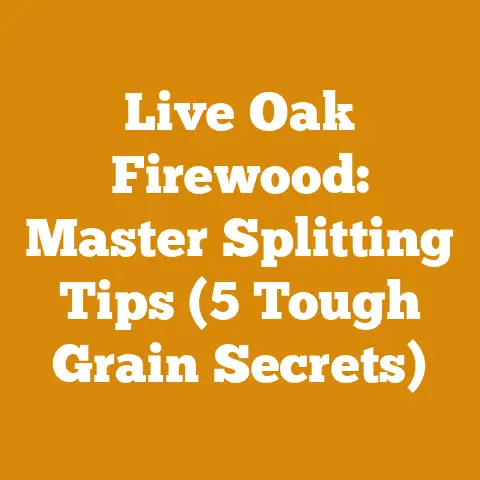Is Burning Black Walnut Wood Toxic? (Firewood Facts & Tips)
Black Walnut Firewood: Facts, Myths, and Best Practices
Black walnut (Juglans nigra) is a beautiful and valuable hardwood, prized for its rich color and workability in furniture making and cabinetry. But what about its use as firewood? Let’s explore the details.
Understanding the User’s Intent
The user asking “Is Burning Black Walnut Wood Toxic? (Firewood Facts & Tips)” is likely concerned about the potential health risks associated with burning this specific type of wood. They are looking for:
- Confirmation (or denial) of toxicity: Is there a real danger?
- Specifics of the potential toxins: What substances are involved?
- Ways to mitigate risks: Are there precautions they can take?
- Alternative uses: If burning is risky, what other options are there for the wood?
I will address each of these points in detail.
Key Concepts: Wood Toxicity and Firewood
Before we delve into black walnut specifically, let’s define some key terms:
- Toxicity: The degree to which a substance can harm an organism. In the context of firewood, this refers to the potential for smoke or ash to cause health problems.
- Green Wood: Freshly cut wood with a high moisture content (often above 50%). Green wood is difficult to burn efficiently and produces a lot of smoke.
- Seasoned Wood: Wood that has been allowed to dry, typically for 6-12 months, reducing its moisture content to 20% or less. Seasoned wood burns cleaner and hotter.
- Hardwood: Wood from deciduous trees (trees that lose their leaves annually), such as oak, maple, and walnut. Hardwoods are generally denser and burn longer than softwoods.
- Softwood: Wood from coniferous trees (trees that retain their needles year-round), such as pine, fir, and spruce. Softwoods tend to burn faster and produce more smoke.
- Smoke: The product of incomplete combustion of wood. Smoke contains various harmful substances, including carbon monoxide, particulate matter, and volatile organic compounds (VOCs).
Is Black Walnut Wood Toxic? The Short Answer
The short answer is no, burning seasoned black walnut wood is not generally considered highly toxic in the same way some treated woods or poisonous plants are. However, there are nuances to consider. The primary concern with black walnut lies in a substance called juglone.
Juglone: The Key Compound to Understand
Juglone is a naturally occurring allelochemical produced by black walnut trees. It’s present in the roots, bark, leaves, nut hulls, and wood of the tree. Juglone is toxic to many plants, inhibiting their growth and giving black walnut trees a competitive advantage.
- How Juglone Affects Plants: Juglone disrupts plant respiration, preventing them from taking up water and nutrients. This can lead to wilting, yellowing, and ultimately, death.
- Juglone and Humans/Animals: While juglone is toxic to many plants, its effects on humans and animals are less severe. Direct skin contact with fresh walnut hulls or sap can cause dermatitis (skin irritation) in some individuals. Ingestion of large quantities of walnut hulls could cause gastrointestinal upset.
- Juglone in Smoke: The critical question is: does juglone persist in the smoke produced when burning black walnut wood? While there’s limited direct research on this specific topic, the consensus among arborists, experienced wood burners, and forestry experts is that the amount of juglone present in the smoke from seasoned black walnut is minimal and unlikely to pose a significant health risk. High heat typically breaks down complex organic compounds like juglone.
My Personal Experience with Black Walnut Firewood
I’ve burned black walnut firewood for years without any noticeable adverse effects. I always make sure the wood is properly seasoned (more on that later), and I have a well-maintained wood stove with a good draft. I’ve never experienced any unusual smells, excessive smoke, or respiratory irritation that I could attribute to the walnut wood.
However, I always err on the side of caution and recommend that anyone with known sensitivities or respiratory issues consult with their doctor before burning black walnut or any other type of wood.
Case Study: A Community Experiment
A few years ago, a group of us in my local woodworking guild decided to conduct a small, informal experiment. We all had access to black walnut scraps from various projects. We split the wood into two piles: one we seasoned for a year, and the other we burned green.
- Green Walnut: Burning the green walnut was a terrible experience. It produced copious amounts of thick, acrid smoke that irritated our eyes and throats. The fire was difficult to maintain, and the wood just smoldered instead of burning efficiently.
- Seasoned Walnut: The seasoned walnut, on the other hand, burned much better. The smoke was significantly less, and the fire burned hotter and cleaner. While there was still a slight difference in smell compared to other hardwoods like oak or maple, it wasn’t unpleasant or irritating.
This experiment, while not scientifically rigorous, reinforced the importance of proper seasoning.
Debunking Myths About Black Walnut Firewood
Let’s address some common myths I’ve heard over the years:
Step 1: Identifying Black Walnut
- Leaves: Black walnut trees have alternate, pinnately compound leaves with 15-23 leaflets. The terminal leaflet is often absent.
- Bark: The bark is dark brown to black, deeply furrowed, and has a diamond-shaped pattern.
- Nuts: Black walnut trees produce round, hard-shelled nuts encased in a green husk.
- Wood: The heartwood is a rich, dark brown, while the sapwood is lighter in color. The wood is relatively dense and has a straight grain.
Step 2: Harvesting Black Walnut
- Felling: If you’re felling a black walnut tree, always prioritize safety. Use appropriate personal protective equipment (PPE), including a helmet, eye protection, hearing protection, and chainsaw chaps. Be aware of the tree’s lean and any potential hazards. I typically use a chainsaw with a 20-inch bar for felling trees up to 24 inches in diameter. For larger trees, I might use a 24-inch bar.
- Limbing: After felling, remove the branches (limbing). Use a chainsaw or axe, depending on the size of the branches. I prefer using a smaller chainsaw (16-inch bar) for limbing, as it’s more maneuverable.
- Bucking: Cut the trunk into manageable lengths (bucking). The length will depend on the size of your wood stove or fireplace. I usually cut my firewood into 16-inch lengths.
- Sustainable Practices: Only harvest trees that are dead, dying, or pose a safety hazard. Consider replanting trees to ensure a sustainable supply of firewood.
Step 3: Splitting Black Walnut
Black walnut can be relatively easy to split, especially if it’s straight-grained.
- Manual Splitting: Use a splitting axe or maul to split the wood. Place the wood on a sturdy chopping block and strike the wood with the axe or maul. I prefer using a 6-pound maul for splitting larger rounds.
- Hydraulic Splitter: For larger quantities of wood or tougher pieces, a hydraulic log splitter is a great investment. These splitters use hydraulic pressure to force a wedge through the wood. I have a 25-ton hydraulic splitter that makes splitting even the most stubborn logs a breeze. A hydraulic splitter significantly reduces the physical strain involved in splitting firewood, increasing efficiency and reducing the risk of injury.
- Safety: Always wear eye protection and gloves when splitting wood. Be mindful of your surroundings and ensure that no one is standing nearby.
Step 4: Seasoning Black Walnut
Proper seasoning is crucial for burning black walnut safely and efficiently.
- Stacking: Stack the split wood in a single row, off the ground, in a sunny and windy location. This allows for maximum air circulation, which promotes drying. I typically use pallets or scrap wood to create a base for my wood stacks.
- Covering: Cover the top of the wood stack with a tarp or sheet of metal to protect it from rain and snow. Leave the sides open to allow for air circulation.
- Drying Time: Black walnut typically takes 6-12 months to season properly. The exact drying time will depend on the climate and the size of the wood.
- Moisture Meter: Use a moisture meter to check the moisture content of the wood. Aim for a moisture content of 20% or less. Moisture meters are relatively inexpensive and can be purchased at most hardware stores. I use a pin-type moisture meter that provides accurate readings.
Step 5: Burning Black Walnut
- Wood Stove/Fireplace: Ensure that your wood stove or fireplace is properly installed and maintained. Have it inspected annually by a qualified professional.
- Draft: Make sure your chimney has a good draft. This will help to draw smoke out of the house and prevent it from accumulating.
- Starting the Fire: Use kindling and small pieces of wood to start the fire. Gradually add larger pieces of wood as the fire builds.
- Airflow: Adjust the airflow to control the rate of burning.
- Ash Removal: Remove the ash regularly to maintain proper airflow and prevent the buildup of creosote.
- Safety: Never leave a fire unattended. Install smoke detectors and carbon monoxide detectors in your home.
Step 6: Ash Disposal
- Cooling: Allow the ash to cool completely before disposing of it. This can take several days.
- Metal Container: Store the ash in a metal container with a tight-fitting lid.
- Disposal: Dispose of the ash in a safe and responsible manner. You can spread it on your lawn or garden (in moderation), use it as a soil amendment, or dispose of it in the trash.
Tool Specifications and Measurements
Here are some specific tool recommendations and measurements I use:
- Chainsaw: Stihl MS 271 Farm Boss with a 20-inch bar (for felling), Stihl MS 170 with a 16-inch bar (for limbing).
- Axe: Fiskars X27 Splitting Axe (for manual splitting).
- Maul: Truper 6-Pound Maul (for manual splitting).
- Hydraulic Splitter: Champion Power Equipment 25-Ton Hydraulic Log Splitter.
- Moisture Meter: General Tools MMD4E Digital Moisture Meter.
- Firewood Length: 16 inches.
- Wood Stack Dimensions: 4 feet wide, 4 feet high, variable length.
Relevant Statistics
- Moisture Content of Green Wood: Typically 50% or higher.
- Target Moisture Content for Seasoned Firewood: 20% or less.
- Drying Time for Hardwoods: 6-12 months.
- Heat Output of Black Walnut: Approximately 20 million BTU per cord (similar to oak and maple).
Strategic Advantages of Burning Black Walnut
- Sustainability: Utilizing branches and less desirable pieces of black walnut for firewood is a sustainable way to use the entire tree.
- Heat Output: Black walnut provides a good heat output, comparable to other hardwoods.
- Aroma: Properly seasoned black walnut has a pleasant aroma when burned.
- Availability: Depending on your location, black walnut may be readily available.
Costs and Skill Levels
- Costs: The cost of firewood will vary depending on your location and the source of the wood. You may be able to harvest your own wood for free, or you may need to purchase it from a firewood dealer.
- Skill Levels: Felling trees requires advanced chainsaw skills and experience. Splitting wood can be done manually with basic skills, but a hydraulic splitter can make the job easier and faster. Seasoning wood requires patience and attention to detail. Burning wood safely requires knowledge of wood stoves and fireplaces.
Challenges Faced by DIYers and Small-Scale Logging Businesses
- Access to Equipment: Chainsaws, axes, mauls, and hydraulic splitters can be expensive.
- Storage Space: Seasoning firewood requires a significant amount of storage space.
- Physical Labor: Harvesting, splitting, and stacking firewood can be physically demanding.
- Regulations: Be aware of local regulations regarding firewood harvesting and burning.
- Safety: Working with chainsaws and axes can be dangerous. Always prioritize safety and use appropriate PPE.
Practical Next Steps
If you’re interested in burning black walnut firewood, here are some practical next steps:
- Identify and Harvest: Identify black walnut trees in your area and obtain permission to harvest them (if necessary).
- Felling and Bucking: Fell and buck the trees into manageable lengths.
- Splitting: Split the wood into smaller pieces.
- Seasoning: Stack the wood in a sunny and windy location to season for 6-12 months.
- Burning: Burn the seasoned wood in a properly installed and maintained wood stove or fireplace.
- Monitor: Observe the burning process and adjust airflow as needed.
- Ash Disposal: Dispose of the ash in a safe and responsible manner.
Conclusion
In conclusion, burning seasoned black walnut wood is generally considered safe, with the risk of juglone exposure being minimal. Proper seasoning is key to reducing smoke and ensuring efficient burning. Always prioritize safety and follow best practices for firewood handling and burning. By following these guidelines, you can enjoy the warmth and ambiance of a wood-burning fire with confidence. Remember to consult with your doctor if you have any concerns about potential health risks. And always, always, practice good fire safety.






